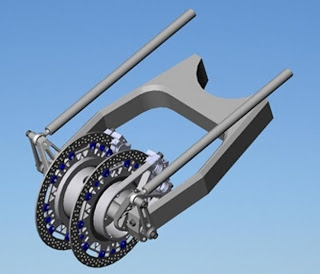




The hub-center steer concept has been around since the 1920 when the brands
Ner-a-Car and others build HCS bikes.
In the 1970s HCS bikes was back on the map when
Jack & Richard Difazio raced HCS bikes in the UK.
In 1985 a one of Yamaha FZ750-powered HCS bike, build by
Leeman Racing Japan, entered the Suzuka 8 Hours by
Team YDS. There was only this prototype build, and can be bourght in the UK for 273,000 $ via race bike specialist Steve Griffiths of Racing & Investment Motorcycles [www.racing-motorcycles.co.uk/ ]
In the 1991 the
Bimota Tesi 1D (designed by
Massimo Tamburini) came on the marked as a production bike. The hub centre steering on the Tesi 1D offered improved ride characteristics, but unfortunately the downside to the steering system was an enormous turning circle making low speed maneuvering a problem. The Bimota Tesi 1D was also expensive and was only produced in very small numbers.
In 1993
Yamaha launched the
GTS1000, and raced at the Isle of Man TT but was heavy and clumsy in use.
After so many years of telescopic forks, people are used to riding a bike that handles in a specific way, and almost expect the limitations. This explains the lack of success that the HCS bikes have had, which is really too bad...






















